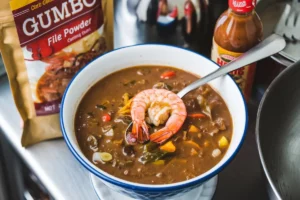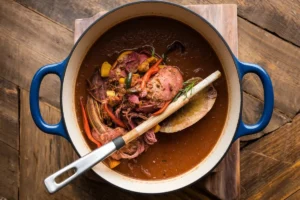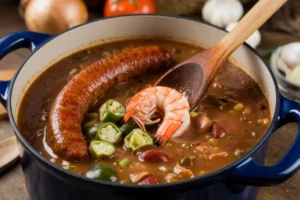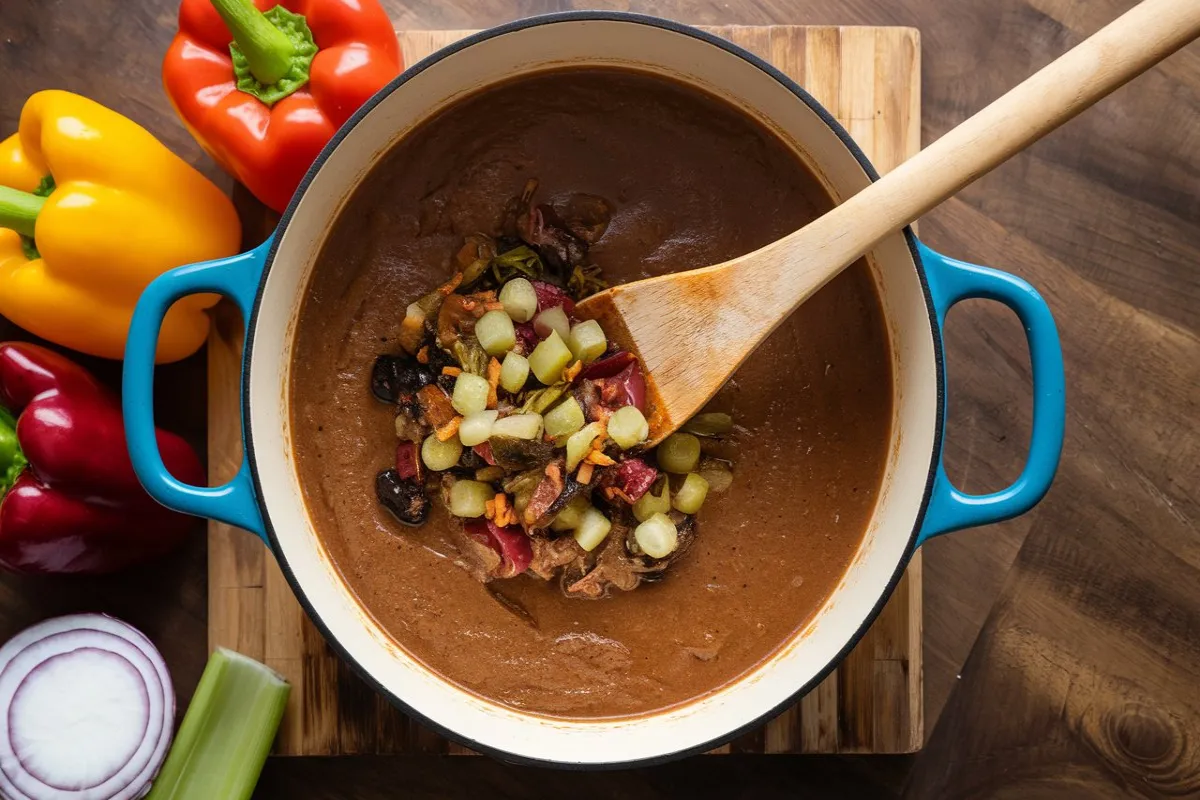Gumbo is more than just a staple of Louisiana cuisine; it’s a cultural icon that tells the story of its people, traditions, and rich culinary heritage. With its deep, complex flavors and comforting texture, gumbo brings together a diverse array of influences, including French, Spanish, African, and Native American. While there are countless ways to make gumbo, two fundamental rules define the essence of this beloved dish: mastering the roux and achieving a harmonious blend of flavors.
To create an authentic gumbo, understanding these two rules is essential. The perfect gumbo captures a balance of ingredients, textures, and techniques that respect tradition while allowing room for creativity. Learn more about the essential steps to perfect your gumbo by exploring this authentic New Orleans gumbo guide, which provides insights into crafting the perfect base and flavor profile.
The Two Fundamental Rules of Gumbo
1. Mastering the Roux
The roux is the heart of any gumbo. This simple mixture of flour and fat (usually oil or butter) is cooked together until it reaches the desired shade, ranging from a light tan to a dark, rich chocolate. The color and depth of the roux significantly influence the flavor of the gumbo, making it one of the most crucial elements of the dish.
- Types of Roux:
- Light Roux: Pale and creamy, ideal for lighter soups and stews but rarely used in traditional gumbo.
- Medium Roux: Golden brown with a nutty flavor; this is often used in seafood gumbo.
- Dark Roux: Deep brown to nearly black, providing a robust, smoky flavor that is classic in Cajun gumbo.
Crafting the perfect roux requires patience and constant stirring over medium to low heat. It can take anywhere from 15 to 45 minutes, depending on the desired depth. The key is not to rush this step; a burnt roux can ruin the entire pot. For a comprehensive guide to making a flawless roux, check out this step-by-step process that emphasizes the importance of technique and timing.
2. Achieving a Harmonious Blend of Flavors
The second cardinal rule of gumbo is to achieve a harmonious blend of flavors. This means balancing the various ingredients—meats, seafood, vegetables, and spices—so that no single element overwhelms the others. The goal is to create a dish where every bite delivers a complex yet unified taste experience.
- Key Ingredients:
- Seafood: Shrimp, crab, and crawfish are popular choices that add sweetness and brininess.
- Meats: Chicken and sausage, especially Andouille or Tasso, provide depth and smokiness.
- Vegetables: The “holy trinity” of onions, bell peppers, and celery forms the base of gumbo, similar to a mirepoix in French cooking.
- Seasonings: A mix of spices, including filé powder (ground sassafras leaves), cayenne pepper, and bay leaves, are essential for that distinctive gumbo flavor.
One of the biggest mistakes is using water instead of stock. A rich stock, whether chicken, seafood, or vegetable, adds depth and enhances the overall flavor profile. You can read more about common gumbo mistakes and how to avoid them in this Southern Living guide.
Additional Essential Guidelines in Gumbo Making

While the two primary rules are critical, there are additional guidelines that can help you refine your gumbo:
- Avoid Un-Cajun Sausage: Authentic Cajun gumbo calls for traditional sausages like Andouille or Tasso. Avoid using generic sausages that don’t complement the dish’s complex flavors.
- Do Not Mix Meat with Seafood: While modern recipes sometimes blend meat and seafood, traditionalists keep them separate. Mixing can muddy the flavors, making it difficult to achieve the right balance.
- Use Stock, Not Water: Always use a flavorful stock as your gumbo base. Water dilutes the flavors, while stock enhances the depth and richness.
Common Gumbo Mistakes and How to Avoid Them
Even seasoned cooks can make mistakes when preparing gumbo. Here are some of the most common pitfalls and tips to avoid them:
- Using Tomatoes in Cajun Gumbo: While tomatoes are acceptable in Creole gumbo, they are not traditionally used in Cajun gumbo. The addition of tomatoes can drastically alter the flavor profile and authenticity.
- Incorrect Gumbo-to-Rice Ratio: The perfect serving of gumbo involves a ratio of two parts gumbo to one part rice. This balance ensures that the gumbo remains the star, with the rice serving as a complement.
- Overcooking Seafood: One of the biggest mistakes is adding seafood too early. Seafood cooks quickly, and overcooking can result in a rubbery texture. Add shrimp, crab, or crawfish in the last few minutes of cooking.

FAQs About Gumbo Rules
- What are the two main rules of gumbo? The two fundamental rules of making gumbo are mastering the roux and achieving a harmonious blend of flavors.
- Can you use tomatoes in gumbo? Tomatoes are traditionally used in Creole gumbo but not in Cajun gumbo.
- What is the right gumbo-to-rice ratio? The ideal ratio is two parts gumbo to one part rice.
- Why is roux important in gumbo? The roux is essential because it serves as the thickener and provides the dish’s distinctive deep flavor.
- Is it okay to mix meat and seafood in gumbo? Traditionally, meats and seafood are kept separate in gumbo, although some modern recipes blend the two.
Variations of Gumbo
Gumbo is a versatile dish with a rich history, and its variations reflect the diverse cultures that have influenced Louisiana’s culinary landscape. From the hearty Cajun style to the tomato-rich Creole version, each gumbo tells its own story through the ingredients and techniques used. Here are some of the most popular variations of gumbo:
1. Cajun Gumbo
Cajun gumbo is often characterized by its dark roux and robust, smoky flavors. This version typically includes a mix of meats, such as chicken, duck, and sausage, particularly Andouille. Unlike Creole gumbo, Cajun gumbo usually does not contain tomatoes, focusing instead on a rich, deep flavor that comes from the roux.
- Key Features:
- Dark roux cooked until it’s nearly black, providing a smoky and nutty flavor.
- Includes the “holy trinity” of Cajun cooking: onions, bell peppers, and celery.
- Often uses sausage and chicken as the main proteins, although seafood can be included.
- Spiced generously with cayenne pepper, black pepper, and thyme.
2. Creole Gumbo
Creole gumbo incorporates tomatoes and is typically lighter than its Cajun counterpart. It blends French, Spanish, and African influences, often featuring a combination of seafood and meats. This version is more common in New Orleans and is known for its more refined and complex flavor profile.
- Key Features:
- Uses a medium to dark roux, but not as dark as in Cajun gumbo.
- Includes tomatoes, which add a slight acidity and sweetness.
- Common proteins include shrimp, crab, oysters, and occasionally chicken or ham.
- Seasoned with filé powder, paprika, and other Creole spices, creating a balanced, flavorful dish.
3. Seafood Gumbo
Seafood gumbo highlights the abundance of fresh seafood found along Louisiana’s coast. It’s typically made with a lighter roux and often includes shrimp, crab, crawfish, and oysters. This type of gumbo is particularly popular during seafood season and is often served during celebrations.
- Key Features:
- Lighter roux to let the delicate flavors of the seafood shine.
- Commonly includes okra or filé powder as a thickener.
- Tends to be slightly spicier, with cayenne pepper adding heat that complements the sweetness of the seafood.
- Can be served with or without rice, depending on regional preferences.
4. Chicken and Sausage Gumbo
This is one of the most popular and hearty versions of gumbo, especially in inland Louisiana where seafood is less accessible. It typically features smoked sausage, such as Andouille, paired with tender pieces of chicken. The combination of these proteins results in a deeply satisfying and flavorful dish.
- Key Features:
- Dark roux base that provides a deep, smoky flavor.
- Often includes okra for additional thickness, though this is optional.
- Heavily seasoned with garlic, onions, and various spices that highlight the richness of the sausage and chicken.
- Frequently enjoyed in the colder months due to its warming, hearty qualities.
5. Gumbo Z’Herbes (Green Gumbo)
Gumbo Z’Herbes is a traditional meatless gumbo often served during Lent when abstaining from meat is common. It’s packed with leafy greens like collards, mustard greens, and spinach, giving it a distinct green color and earthy flavor. However, many modern versions now include meats for added depth.
- Key Features:
- Typically features a lighter roux or none at all.
- Includes a variety of greens, often up to seven types, symbolizing good luck.
- Can include ham, sausage, or other smoked meats if not observing Lent.
- Seasoned with garlic, onions, and peppers to enhance the natural flavors of the greens.
6. Duck and Andouille Gumbo
This variation highlights the rich flavors of duck combined with the smokiness of Andouille sausage. It’s a popular choice during hunting season in Louisiana when fresh duck is readily available.
- Key Features:
- Made with a dark roux that pairs well with the bold flavors of the duck.
- Often includes a splash of sherry or wine to deglaze the pan and add complexity.
- The addition of mushrooms and green onions can add extra layers of flavor.
- Served with rice, providing a comforting and hearty meal.
Regional Influences on Gumbo
Gumbo’s variations are also shaped by the specific region of Louisiana where it is prepared:
- New Orleans: Known for its Creole gumbo, which often includes a wide array of seafood, tomatoes, and a lighter roux. The city’s multicultural influence is evident in the dish’s complex flavor profile.
- Acadiana (Cajun Country): Home to the rustic Cajun gumbo, often featuring game meats like duck, andouille, and wild-caught seafood. The roux here is darker, and the flavors are bolder and spicier.
- Bayou and Coastal Regions: These areas are famous for their seafood gumbo, making the most of local shrimp, crabs, and fish. The use of okra is more common here, adding a unique texture and flavor.
Final Thoughts on Gumbo Variations
Gumbo is as diverse as the people who make it, reflecting the unique history and culture of Louisiana. Whether you prefer a rich, smoky Cajun gumbo or a lighter, tomato-infused Creole version, each pot tells a story of tradition, adaptation, and culinary creativity. By exploring these variations, you can find the style that resonates most with your taste and honor the diverse legacy of this quintessential Louisiana dish.
Tips for Making the Perfect Gumbo

Creating the perfect gumbo requires attention to detail, patience, and a respect for tradition. Here are some tips that will help you elevate your gumbo-making skills and ensure that your dish turns out flavorful, balanced, and authentic every time:
1. Choose Fresh, High-Quality Ingredients
- Use the freshest seafood, meats, and vegetables you can find. Fresh ingredients contribute to the overall flavor and texture of the gumbo.
- Opt for local or wild-caught seafood when possible, as it tends to have a more pronounced flavor compared to frozen or farm-raised options.
2. Take Your Time with the Roux
- Roux is the most important element of your gumbo, so take your time to get it right. Cook it slowly over medium to low heat, stirring constantly.
- Be patient: a dark roux can take up to 45 minutes to achieve. If you rush, you risk burning it, which will impart a bitter taste to the entire dish.
3. Layer Your Flavors
- Start by building flavors from the base up. Sauté the holy trinity (onions, bell peppers, and celery) in the roux until soft and aromatic.
- Add spices gradually and taste as you go. This will help you adjust the seasoning and achieve the perfect balance.
4. Use Homemade Stock Whenever Possible
- Homemade stock adds depth and complexity that store-bought versions often lack. Use chicken, seafood, or vegetable scraps to make a rich stock.
- If you must use store-bought stock, choose low-sodium versions so you can control the saltiness of your gumbo.
5. Don’t Skimp on the Seasonings
- Gumbo relies on a rich blend of spices, including filé powder, cayenne pepper, black pepper, thyme, and bay leaves. These seasonings bring out the characteristic flavors of the dish.
- Taste as you cook and adjust seasonings accordingly. Remember, gumbo should be bold and flavorful, but not overpowering.
6. Add Seafood Towards the End
- Seafood, such as shrimp, crab, and oysters, should be added in the last few minutes of cooking to prevent overcooking. Overcooked seafood becomes rubbery and loses its delicate flavor.
- If using fish, gently fold it in at the end and let it cook for just a few minutes until it’s opaque and flaky.
7. Maintain the Correct Gumbo-to-Rice Ratio
- The traditional serving ratio is two parts gumbo to one part rice. This balance ensures that the gumbo remains the star of the dish, with the rice serving as a supporting element.
- Avoid drowning the gumbo in rice, which can dilute its rich, complex flavors.
8. Finish with Fresh Herbs and Garnishes
- Fresh chopped parsley, green onions, and a sprinkle of filé powder can add a fresh burst of flavor to the finished dish.
- Serve your gumbo with a side of hot sauce, allowing guests to adjust the heat to their preference.
9. Let the Gumbo Rest
- Gumbo often tastes better the next day as the flavors have time to meld and deepen. If you can, make your gumbo a day ahead and reheat it slowly on the stove before serving.
- Resting also allows the roux to thicken the gumbo to the perfect consistency.
10. Serve with the Right Accompaniments
- Gumbo is traditionally served over rice, but you can also enjoy it with French bread, cornbread, or potato salad. These sides help balance the dish and add extra comfort.
- Consider pairing your gumbo with a crisp salad or sautéed greens to add a refreshing contrast to the rich, hearty stew.
By following these tips, you can master the art of making gumbo that not only tastes authentic but also showcases the best of Louisiana’s culinary traditions. Whether you’re a first-time cook or a seasoned chef, perfecting your gumbo is a rewarding journey that brings a taste of the South into your kitchen.
Conclusion
By adhering to the two main rules of gumbo—mastering the roux and balancing the flavors—you can create a gumbo that not only tastes amazing but also honors the rich traditions of Louisiana. Gumbo is a dish that invites experimentation within the boundaries of its foundational rules, allowing you to make it your own while still respecting its heritage. Whether you stick strictly to tradition or add your personal touch, remember that the best gumbo is one that brings joy, warmth, and a taste of the South to your table.




